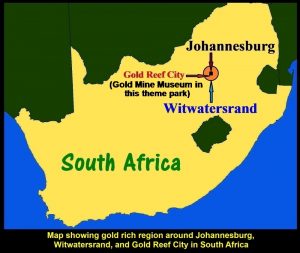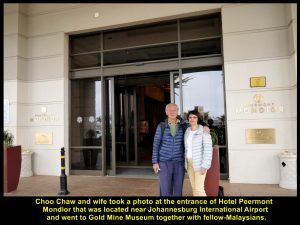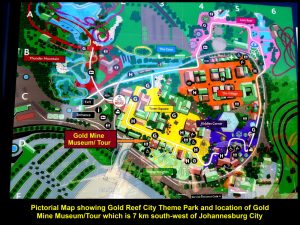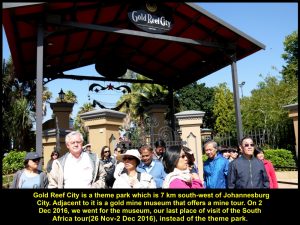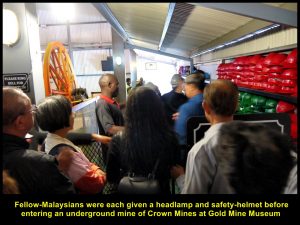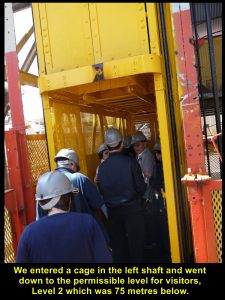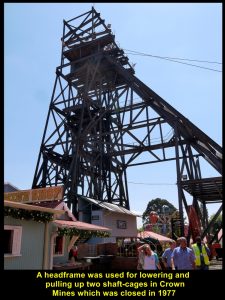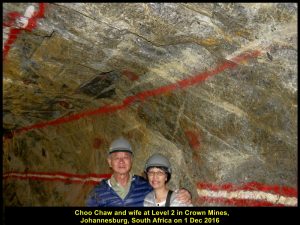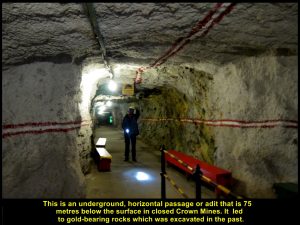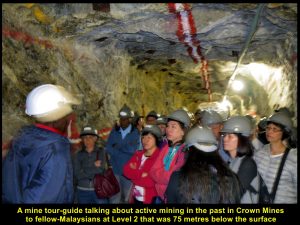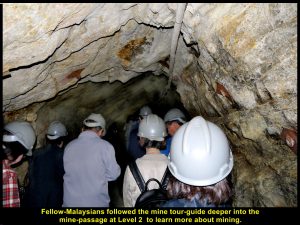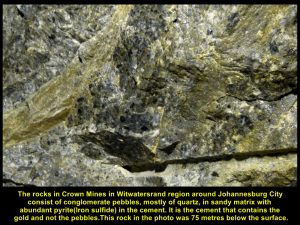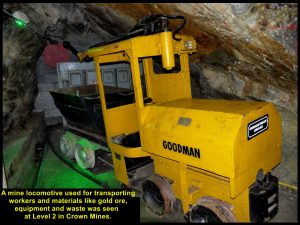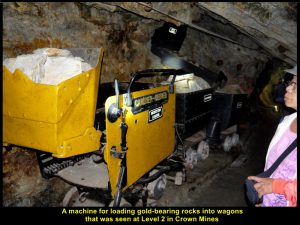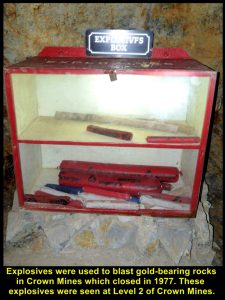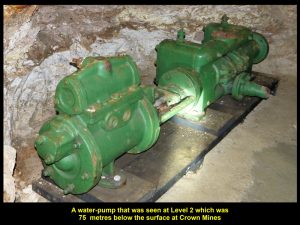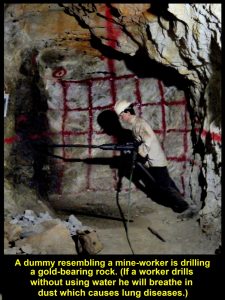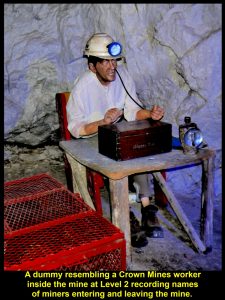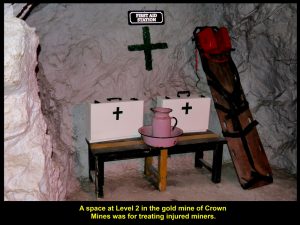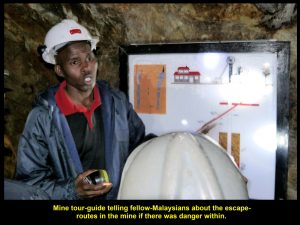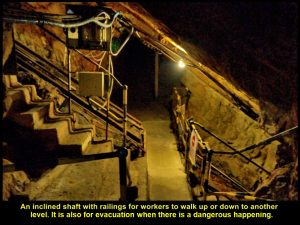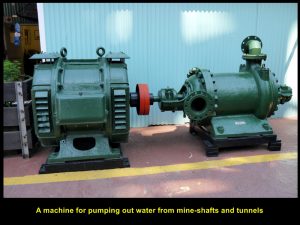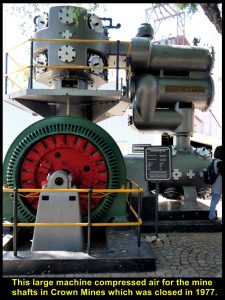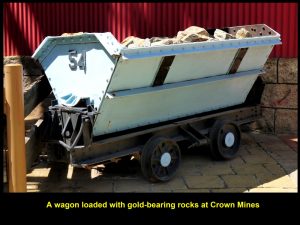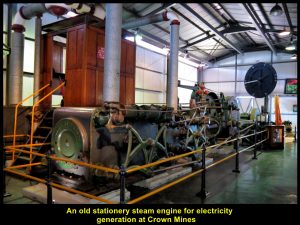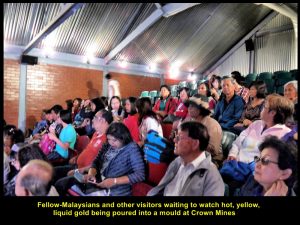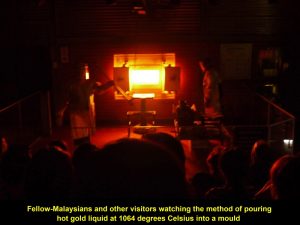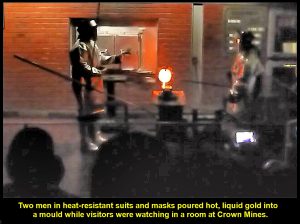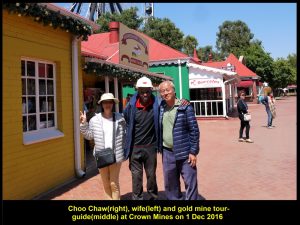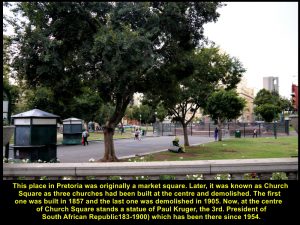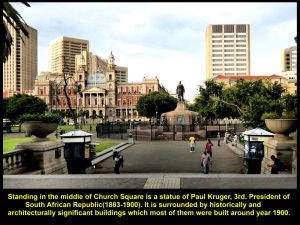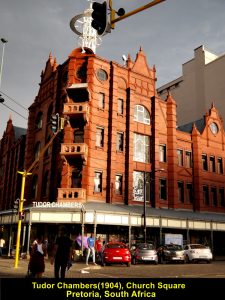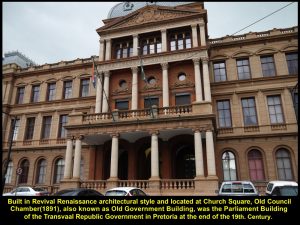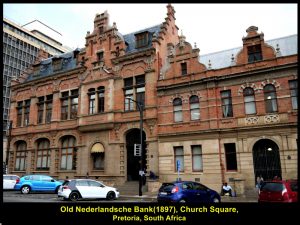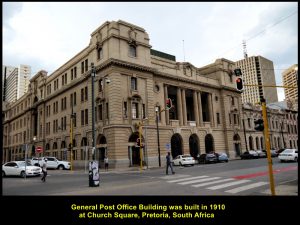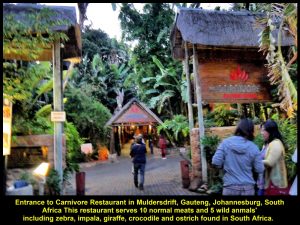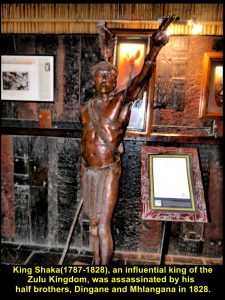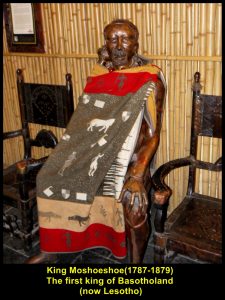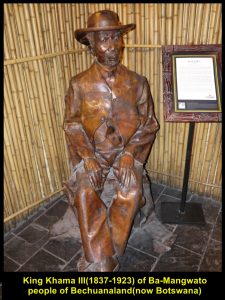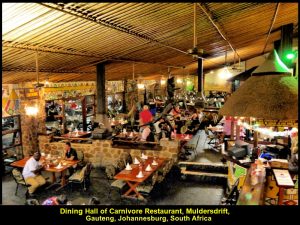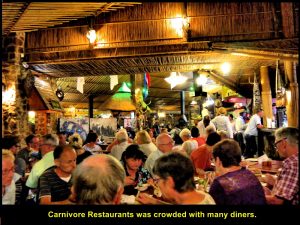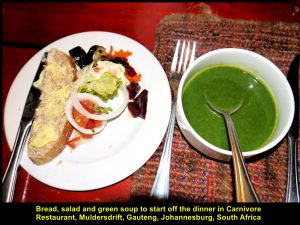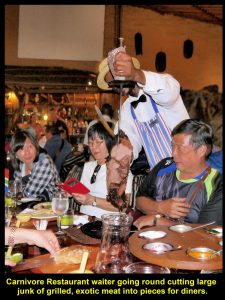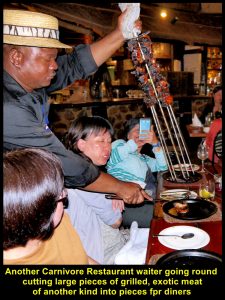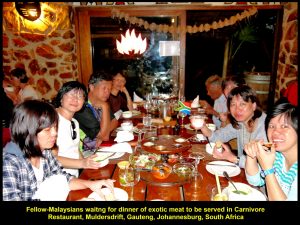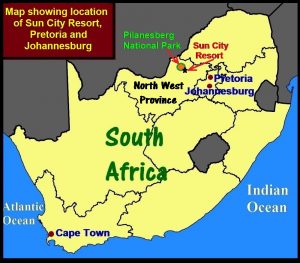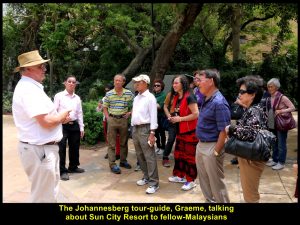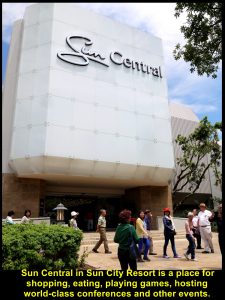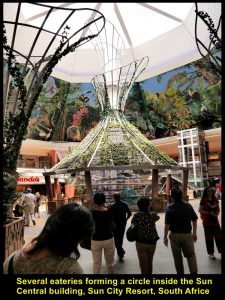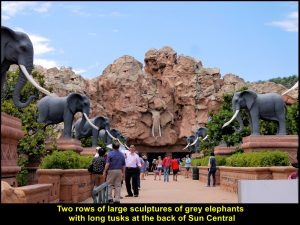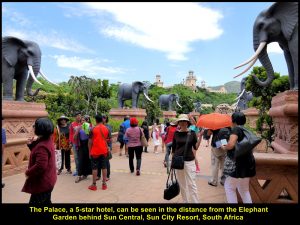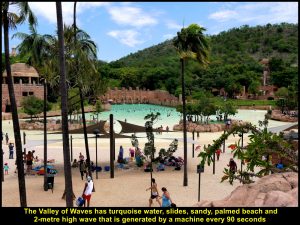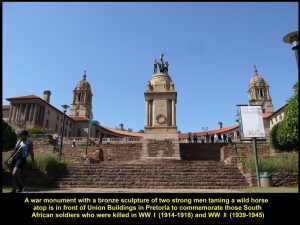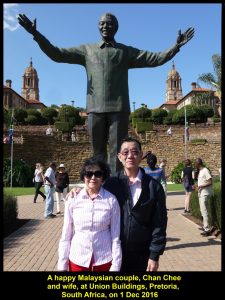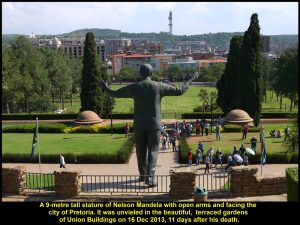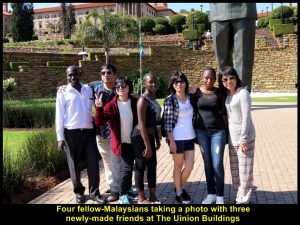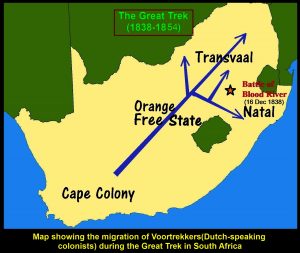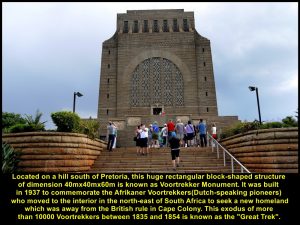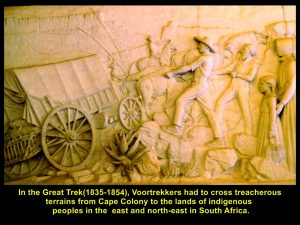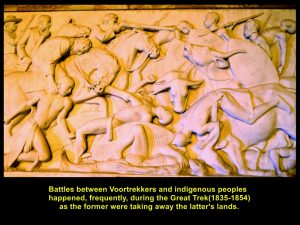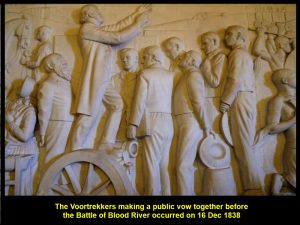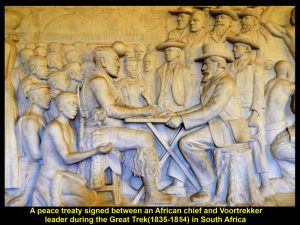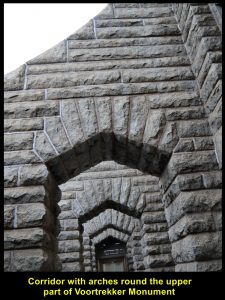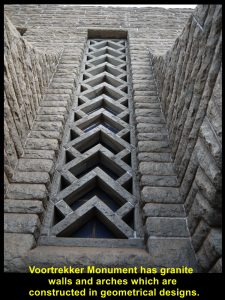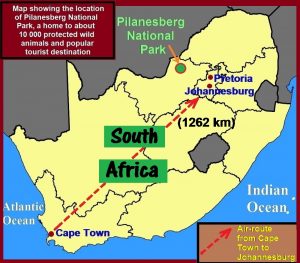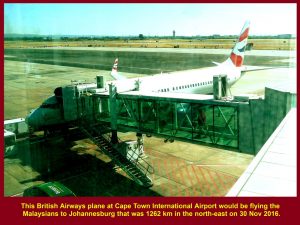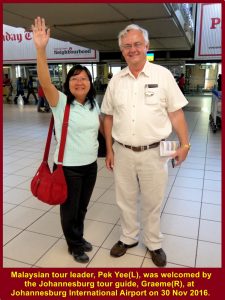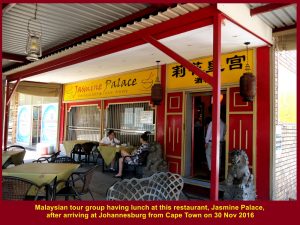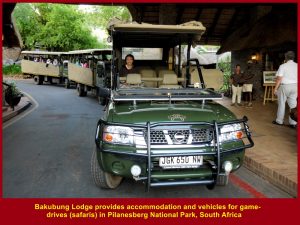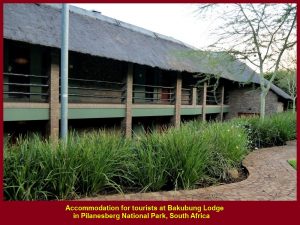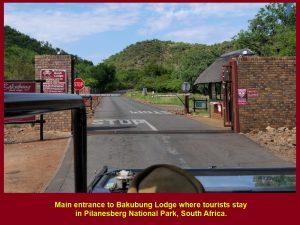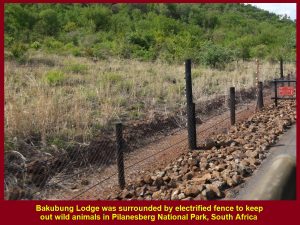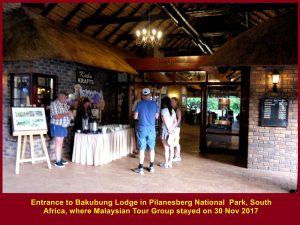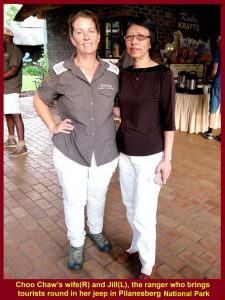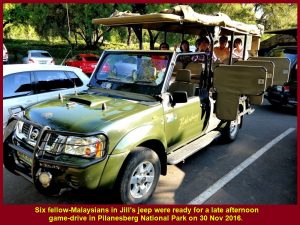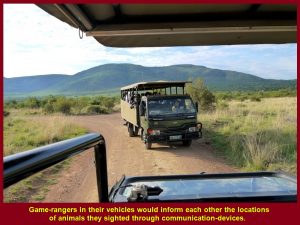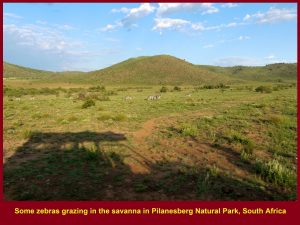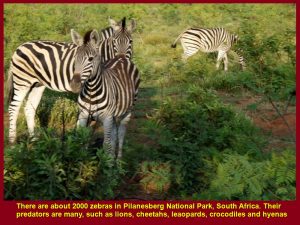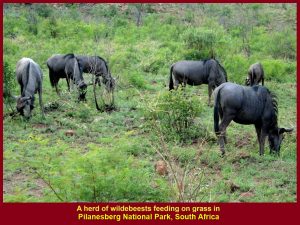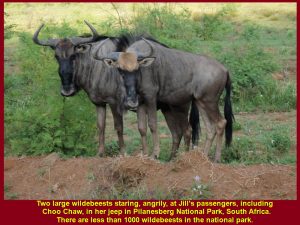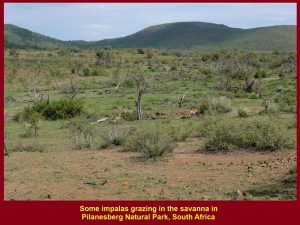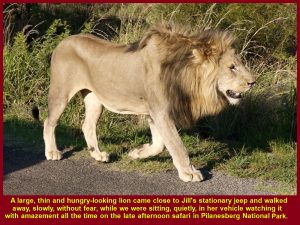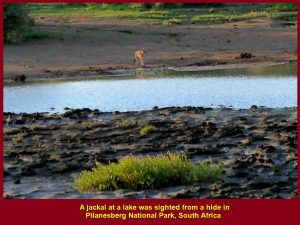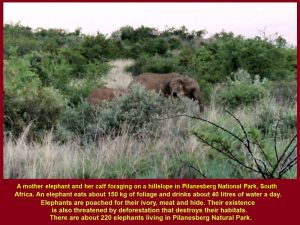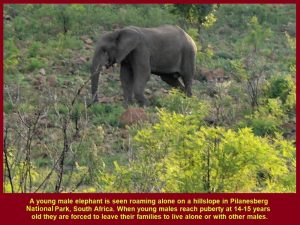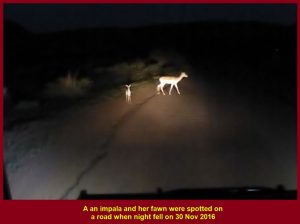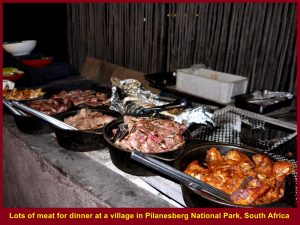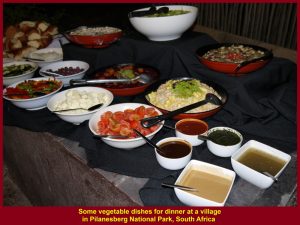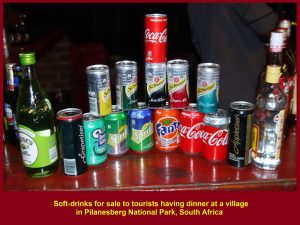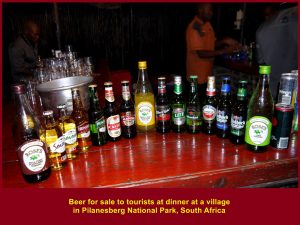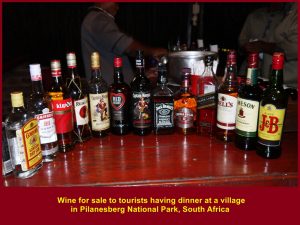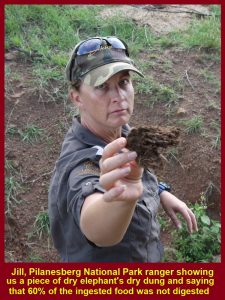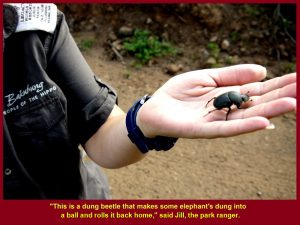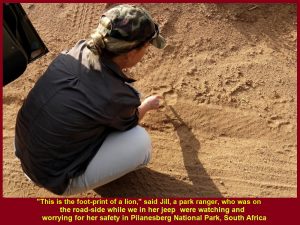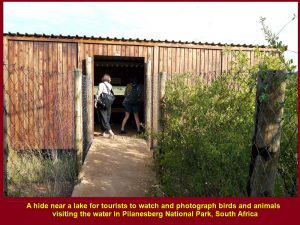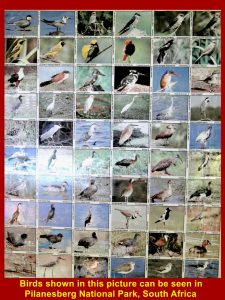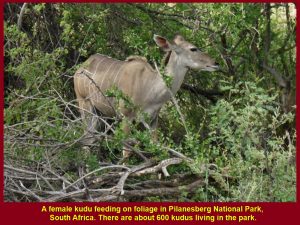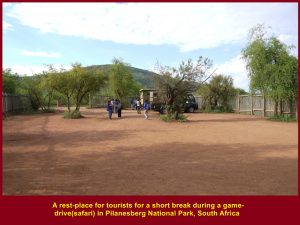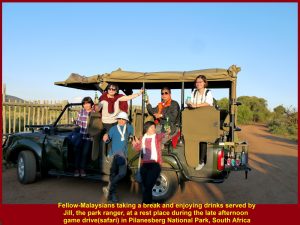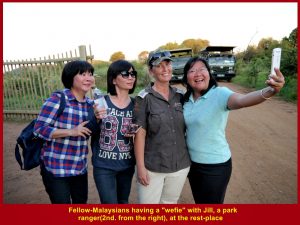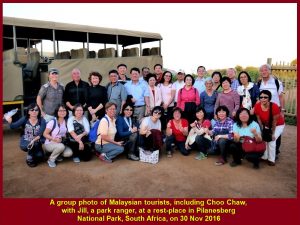South Africa Travel Final Part: Gold Reef City: Gold Mine Museum
Filed under: South Africa Travel Final Part: Gold Reef City: Gold Mine Museum
South Africa Travel Final Part: Gold Reef City: Gold Mine Museum
Friday, 2 Dec 2016
Gold Reef City: Gold Mine Museum
This Friday was our last day in South Africa before we went back to Malaysia, our homeland, in the evening. But we had one more place to visit in the morning. It was a gold mine museum which was in a theme park known as Gold Reef City that was located 7 km south-west of Johannesburg City. The museum offered an underground mine tour.
Underground Gold Deposit
Witwatersrand region around Johannesburg City has the largest underground gold deposit in the world. 50% of the world’s gold production is from this region.
When gold was first discovered in 1886 in this region gold prospectors from within and without South Africa rushed to the place and started drilling for the underground gold.
Crown Mines Group
Crown Mines Group, one of the gold prospectors, started mining in 1916 at the place known as Shaft 14 which is now located in Gold Reef City Theme Park. It closed Shaft 14 in 1977 when the depth of the mining level had reached 3293 metres below the surface. In 1979, it donated the land to Rand Mines which turned it into a museum.
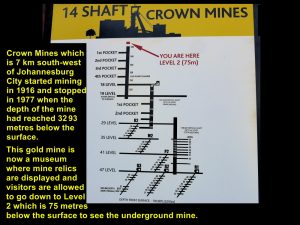
Crown Mines owned Shaft 14 and the diagram shows that gold had been mined to the level, 3293 metres below the surface.
Gold Mine Tour
After breakfast at Hotel Peermont Mondior that was near Johannesburg International Airport, we travelled to Gold Reef City, a theme park. When we reached the park, there were many people, young and old from all walks of life, waiting for the gate to be opened before they could go in and enjoy the kinds of thrills they liked inside.
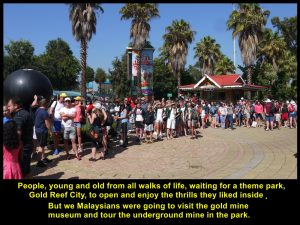
People of all ages and from all walks of life waiting outside Gold Reef City where they could enjoy many thrills
When it was opened, we passed through it to get to the gold mine museum. The mine was originally owned by Crown Mines Group which started mining the place in 1916 and closed it in 1977 when the shaft known as Shaft 14 reached a depth of 3293 metres below the surface.
Shaft 14
At the museum, a mine tour-guide greeted us and gave each of us a headlamp and safety-helmet. Then we followed him to Shaft 14, entered the shaft-cage or elevator which brought us to Level 2 that was 75 metres below the surface.
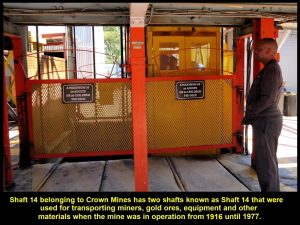
Shaft 14 of Crown Mines has two shafts for transporting miners, equipment and materials from 1916 until 1977
Head-Frame and Winder
The cage was lowered into Shaft 14 by a cable that went round a tall head-frame and to a hoist-machine or winder outside the shaft.
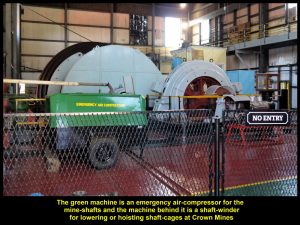
Air-compressor(green) for pumping air into shafts and shaft-winder for lowering or hoisting cage or elevator in shafts
Acid Mine Water
Although the maximum depth of the mine was about 3293 metres underground, most of the shafts had been filled with acid mine water. The acid was produced when rain-water flowed into the shaft and reacted with sulfides of iron in the underground rocks.
Underground Mine Tour
At Level 2, our mine-guide gave us a good lesson on mining, uses of machines, safety measures, first-aid given to injured miners, etc.
Gold-Bearing Rocks
The rocks in the mine of Crown Mines consist of conglomerate pebbles, mostly of quartz, in sandy matrix with abundant pyrite(iron sulfide) in the cement. It is the cement that contains the gold and not the pebbles. Less than one gram of gold can be extracted from one ton of gold-bearing rock in the underground mine. But this amount varies from place to place.
Relics at Level 2
There were several relics of the mine left behind at Level 2 for visitors to see, such as locomotive, wagons, explosives, fuses, mercury arc rectifier and a few more.
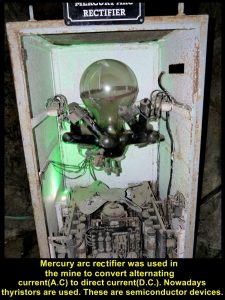
An old mercury arc rectifier for converting alternating current into direct current for machines in the gold mine
Mine-Workers’ Jobs
In the mine dummies were used to show visitors the jobs mine-workers used to do, e.g. drilling, taking attendance of workers and loading rocks.
First Aid
A space at Level 2 in the mine was used for treating injured workers when the mine was in operation.
Escape Routes
The mine tour-guide showed us the inclined shafts in the diagram which workers could walk up or down to go to another level or used them as escape routes for evacuation in case of explosion, tunnel collapse or other dangerous happenings in the underground mine.
After an educational tour of the underground mine, we went back to the surface and waited for a hot liquid gold pouring demonstration in a room.
Relics left behind on the Ground by Crown Mines
While waiting for the demonstration, I looked around and saw some relics left behind by Crown Mines, e.g. locomotive, wagons, generators, water-pumps, winders, etc.
Gold Pour Demonstration
In the demonstration in a room, two men brought out a container of liquid gold from an oven with temperature of over 1063 degrees Celsius(melting point of gold is 1063 degree Celsius) and poured it into a mould. When gold solidified, it weighed about 12.5 kg.
Gold Ingot or Bar
After the demonstration, visitors were asked to see a gold ingot or bar in front. Everybody was eager to touch the precious, yellow metal. The bar was about 99.5% and weighed 12.5 kg. It was worth about USD540,000 at the rate of about USD43,000 per kg on 2 Dec 2016, the day we watched the gold pour demonstration.
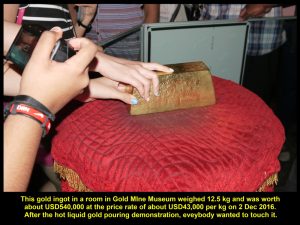
Everybody wanted to touch the gold bar weighing 12.5 kg and worth USD540,000 at current price rate on 2 Dec 2016.
Photo with Mine Tour-Guide
Before we left the gold mine museum for Johannesburg International Airport, my wife and I took a photo with the friendly mine tour-guide.
Johannesburg International Airport
At 10.30 a.m. we, finally, left the museum and headed straight for Johannesburg International Airport or O.R. Tambo International Airport named after Oliver Tambo, a former President of African National Congress, in 2006.
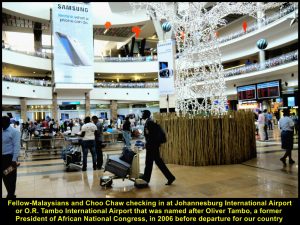
Fellow-Malaysians and Choo Chaw checking in and flying off at Johannesburg International Airport on 2 Dec 2016 for home
Departure for Homeland, Malaysia
After checking in and waiting for a few hours at the airport, we, at last, flew away from Johannesburg at 2.30 p.m. to return to our homeland, Malaysia.
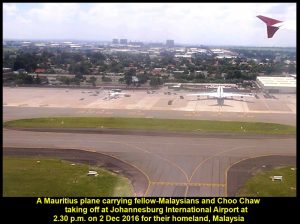
A Mauritius plane carrying fellow-Malaysians and Choo Chaw flying away from Johannesburg to their homeland, Malaysia, on 2 Dec 2016
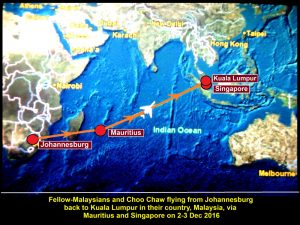
Air-route from Johannesburg to Kuala Lumpur taken by a Mauritius plane that carried fellow-Malaysians and Choo Chaw
An Unforgettable South African Tour from 28 Nov-2 Dec 2016
Well, that was an unforgettable tour in South Africa. We have gained quite a lot of knowledge about South Africa, like her landscapes, people’s way of life, wild animals, mining activities, and many more.
Thanks for reading about this tour and hope it is helpful to you, if you plan to make a trip there.
The End
Written by Choo Chaw
South Africa Travel Part I: Air Flight from KLIA to Cape Town, Cape Town Shantytowns
South Africa Travel Part II: Table Mountain, Malay Quarter, Castle of Good Hope. A & V Waterfront
South Africa Travel Part III: Hermanus, Cheetah Outreach, Stellenbosch, Jewel Africa
South Africa Travel Part V: Pilanesberg National Park(Game Drives/Safaris)
South Africa Travel Part VI: Sun City Resort, Union Buildings, Vootrekker Monument
South Africa Travel Part VII Kruger Museum, Church Square, Melrose House, Carnivore Restaurant
South Africa Travel Final Part Gold Reef City, Gold Mine Museum
South Africa Travel Part VII: Kruger Museum, Church Square, Melrose House, Carnivore Restaurant
South Africa Travel Part VII: Kruger Museum, Church Square, Melrose House, Carnivore Restaurant
(Continue from South Africa Part VI)
Day 6 Thursday, 1 Dec 2016
Kruger Museum
After a visit to Voortrekker Monument where we learned about the history of Voortrekker(Dutch-speaking pioneers), we went to the city of Pretoria and stopped in front of a house which was already closed in the evening. That single-storeyed, wooden, Victorian-styled house was built in 1884 as a private residence for Paul Kruger and his family. It was located along Nkomo Street.
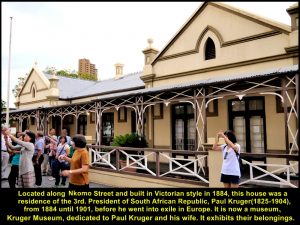
Kruger Museum, a former residence of Paul Kruger, the 3rd. President of South African Republic(1883-1900)
Paul Kruger
Paul Kruger(1825-1904) was a Boer leader and former President of South African Republic(Transvaal) from 1883 until 1900. During the Second Boer War(1899-1902) between the British Empire and Kruger’s men(Boers) in South Africa he went into exile in Europe where he died in Switzerland in 1904. The British won the war in 1902.
The house was restored in its original form and in 1934 it was opened to public as a museum, Kruger Museum. In the museum, visitors can see many things belonging to Paul Kruger and his wife.
Statues of White Lions
As it was already closed when we arrived at the museum, we spent several minutes looking at its front. There were two statues of white lions in front of the entrance that attracted our attention. They were birthday gifts given on 10 Oct 1896 by a mining magnate, Barney Barnato, to Paul Kruger who was the President of South African Republic(Transvaal) then.
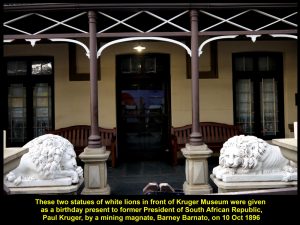
Two statues in front of Kruger Museum given as birthday gifts for Paul Kruger in 1896 by a mining magnate, Barney Barnato
Kruger Church
Looking across the road from the museum, I saw a church where Paul Kruger attended church services, frequently. It was officially opened by Paul Kruger in 1897. Originally, the church was known as The Dopper Church, and later Reformed Church Pretoria. But now it is known as Kruger Church.
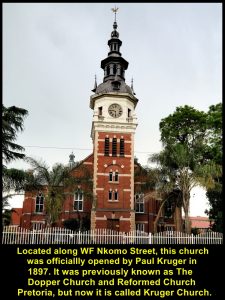
Kruger Church, a place opposite Kruger Museum where Paul Kruger attended church services, frequently
Church Square
Then we went to another place in the old town of Pretoria. It was a market place in the olden days. Later, a succession of three churches were built and demolished in the centre of the area. The first church was built in 1857 and the last one was demolished in 1905. As three churches had been built there, the people of Pretoria called it Church Square.
Statue of Paul Kruger
In the centre of the square stands a statue of a former President of South African Republic(1883-1900) on a high plinth, Paul Kruger(1825-1904). It was erected there in memory of Paul Kruger, a Boer leader who fought against the British Empire for the independence of Transvaal and former President of Transvaal or South African Republic(1883-1900).
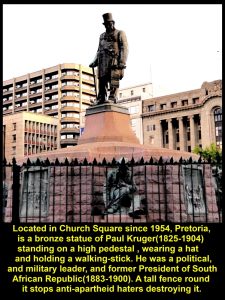
Statue of Paul Kruger holding a walking-stick and wearing a hat on a high plinth in the centre of Church Square
Old Buildings
There are many old but historically and architecturally significant buildings sited around the square. They were built around the year 1900, such as Palace of Justice(1902, Tudor Chambers(1904), Old Council Chamber(1891), Old Nederlandsche Bank(1897), and General Post Office(1910).
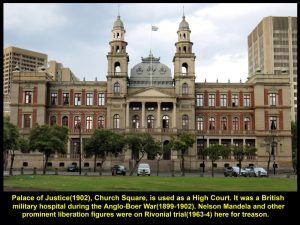
Palace of Justice, is a high court where Nelson Mandela was put on Rivonial trial for treason in 1963-4
Melrose House
After a short stay at Church Square, we went to Burgers Park in the centre of Pretoria City to see an elegant mansion built in 1886.
Known as Melrose House, it was owned by a wealthy businessman, George Jesse Heys. He and his family stayed there until it was taken over by the British forces that used it as military headquarters in 1900 during the Second Boer War(1899-1902). The war was fought between the Boers and the British soldiers. Boers were descendants of the Dutch-speaking settlers in South Africa. The war ended when the Treaty of Veereniging was signed on 31 May 1902 in the mansion which later became well-known.
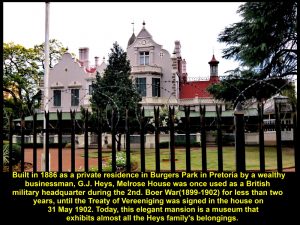
Melrose House was built in 1886 as a private residence for Heys and is now a museum that exhibits the belongings of the Heys’ family and a room where the Treaty of Vereeniging was signed in 1902.
Melrose Museum
This beautiful house is now a museum that has many exhibits belonging to the Heys family, such as paintings by British artists, exquisite carpets, ornate ceilings and fireplaces, original furniture, stained glass-windows, and many more.. Besides, the museum has a room and table on which the Treaty of Vereeniging was signed in 1902. Annual antique markets are held on its premises.
When we arrived at the museum in the evening it was closed to public. So, all we could do was to look at it from outside its fence for a few minutes before we went off for dinner.
Carnivore Restaurant
For dinner, we travelled to a restaurant known as Carnivore Restaurant in Muldersdrift, Gauteng, Johannesburg, which was 50 km south-west of Church Square in Pretoria. It served exotic meat, i.e. meat of game or wild animals, such as zebra, crocodile, impala, and kudu.
The restaurant had a large dining hall. While walking along a passage-way to the hall, we saw on both sides some wooden, life-sized statues of South African tribal chiefs and a politician, such as the following:
a. King Shaka(1787-1828) was an influential king of the Zulu Kingd0m. He was assassinated by his half-brothers, Dingane and Mhlangana, in 1828.
b. King Mzilikazi(1790-1868) was the king of Matabele Kingdom which he founded. He was considered as one of the greatest African military leaders.
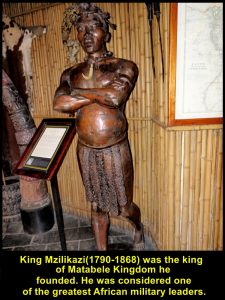
King Mzilikazi(1790-1868) was king of Matabele Kingdom he founded. He was considered as,one of the greatest African military leaders.
c. King Kgosi Mogale Mogale(1795-1869) was the king of Ba Po Ba Mogale Kingdom. His people remembered him for his bravery, diplomacy and leadership.
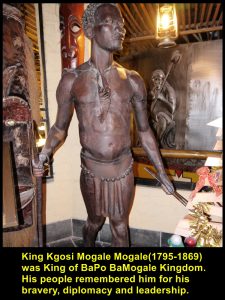
King Kgosi Mogale Mogale(1795-1869) was king of Ba Po Ba Mogale Kingdom. His people remembered him for his bravery, diplomacy and leadership.
d. King Moshoeshoe(1787-1879) was the first king of Basotholand(now Lesotho).
e. King Khama III(1837-1923) was the king of Ba Mangwato people of Bechuanaland(now Botswana).
f. Mokope Modjadji(1936-2001) was the 5th. Rain Queen of the Balobeda tribe in Limpopo Province of South Africa from 1981 until 2001. Rain Queen was believed by her people to have special powers, like the ability to control clouds and rainfall.
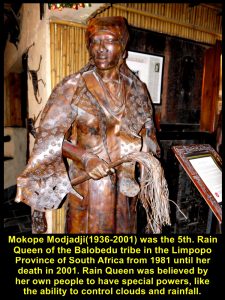
Mokope Modjadji(1936-2001) was the 5th. Rain Queen of the Balobedu tribe on the Limpopo Province of South Africa from 1981 until 2001. Rain Queen was believed by her people to have special powers, like the ability to control clouds and rainfall.
g. Nelson Mandela(1918-2013) was an anti-apartheid activist, political prisoner for 27 years, politician, philanthropist and the first elected President of South Africa(1994-1999).
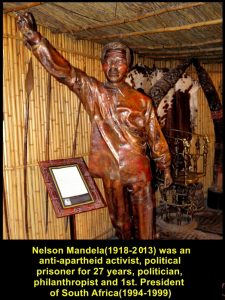
Nelson Mandela(1918-2013) was an anti-apartheid activist, political prisoner for 27 years, politician, philanthropist and first elected President of South Africa(1994-1999)
Dining Hall
In the dining hall of Carnivore Restaurant, we sat at the tables reserved for us. The hall was crowded with many diners from far and wide.
First Serving
A bowl of green-coloured soup and plate of bread and salad were first served to us. Then one waiter after another with different grilled exotic meat on long, large skewers came to our tables and cut a large piece of the meat for each of us.
Exotic Meat for Dinner
The kinds of meat we were given for the dinner were zebra, impala, kudu, venison(deer) and crocodile. Domestic animals’ meat was served, too, namely chicken, lamb and beef. Most of us did not enjoy eating the exotic meat as some were tasteless, rubbery and tough.
The meat I liked was the crocodile meat which was soft and tender, and venison sausage and balls, too. Anyway, we, Malaysians, enjoyed the fellowship atmosphere while having dinner together at the restaurant.
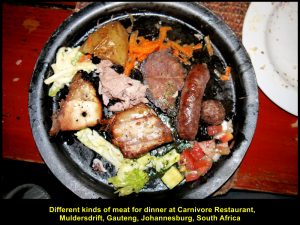
A hot-plate of exotic meat of zebra, impala and kudu, and domestic animals’ meat of chicken and lamb, together with some vegetables
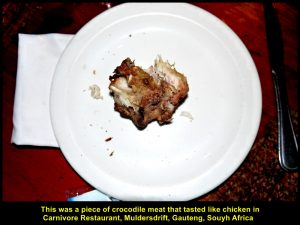
A piece of crocodile tasted better than other exotic meat as it was tender and soft, and tasted like chicken-meat.
Large Open-Air Stove
During dinner, I walked to a large open-air, circular stove in the centre of the dining hall. Large junks of meat of zebra, impala, kudu and crocodile on large skewers were roasted over the hot stove. Besides, domestic meat of chicken, beef and lamb were grilled over it.
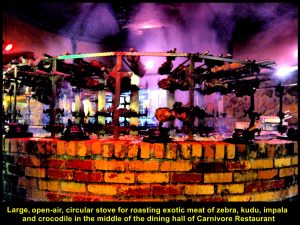
Large junks of exotic meat were roasted over a large open-air, circular stove at Carnivore Restaurant
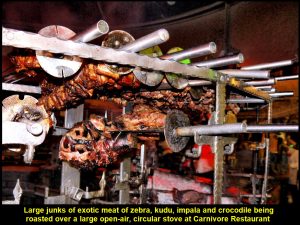
Large junks of exotic meat were roasted over a large open-air, circular stove at Carnivore Restaurant
A Picture of Game-Animals
There was a picture of four game-animals, zebra, kudu, impala and crocodile, near the stove, implying that the meat of those game-animals was for the dinner.
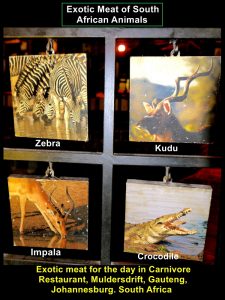
Meat of four game-animals, viz. zebra, kudu, impala and crocodile, was for the dinner at Carnivore Restaurant
Happy Mood Before Dinner
As our fellow-Malaysians were in happy mood before the dinner started at Carnivore Restaurant, I went round taking photos of them. See them in the photos below.
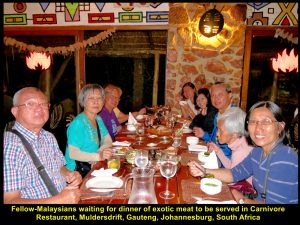
Fellow-Malaysians at another table were in happy mood before dinner of exotic meat at Carnivore Restaurant.
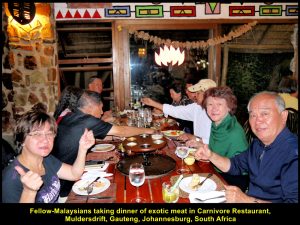
Fellow-Malaysians at the last table were in happy mood before the dinner of exotic meat at Carnivore Restaurant
Peermont Mondior Hotel
After dinner at Carnivore Restaurant, we left for a hotel, Peermont Mondior Hotel, which was 50 km south-east of the restaurant, but near Johannesburg International Airport or O.R. Tambo International Airport. We stayed there for a night and would leave for a gold mine museum in the morning.
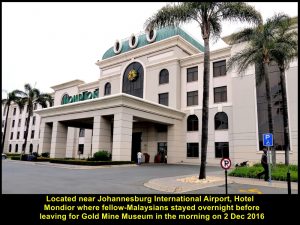
Hotel Peermont Mondior where Malaysians stayed overnight near Johannesburg International Airport
(continue in South Africa Travel Final Part)
Written by Choo Chaw
South Africa Travel Part I: Air Flight from KLIA to Cape Town, Cape Town Shantytowns
South Africa Travel Part II: Table Mountain, Malay Quarter, Castle of Good Hope. A & V Waterfront
South Africa Travel Part III: Hermanus, Cheetah Outreach, Stellenbosch, Jewel Africa
South Africa Travel Part V: Pilanesberg National Park(Game Drives/Safaris)
South Africa Travel Part VI: Sun City Resort, Union Buildings, Vootrekker Monument
South Africa Travel Part VII Kruger Museum, Church Square, Melrose House, Carnivore Restaurant
South Africa Travel Final Part Gold Reef City, Gold Mine Museum
South Africa Travel Part VI : Sun City Resort, Union Buildings, Voortrekker Monument
Filed under: South Africa Travel Part VI : Sun City, Union Buildings, Voortrekker Monument
South Africa Travel Part VI : Sun City Resort, Union Buildings, Voortrekker Monument
(Continue from South Africa Travel Part V)
Day 6 Thursday, 1 Dec 2016
Sun City Resort
After a game-drive(safari) in the morning in Pilanesberg National Park, we went to Sun City Resort located in a hilly area near the park.
Sun City Resort has four hotels with casinos ranging from 3 to 5 stars, world-class golf courses, a theme- park, a shopping centre, an artificial, sandy beach with palm-trees, two-metre high artificial waves, and many more.
The Palace
On arrival at the resort, we had a glimpse of the 5-star hotel, The Palace, which looked like ancient Arabian buildings we see in Aladdin’s movies.
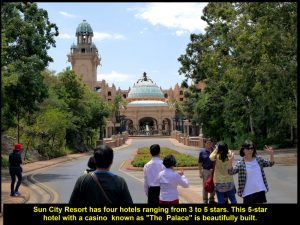
The Palace, a 5-star hotel with casino, in Sun City Resort, near Pilanesberg Natural Park, South Africa
Sun Central
Then we went to another building nearby, Sun Central, where visitors could shop. dine and play games. This building has hosted world-class conferences, national and world beauty-pageants, and other activities.
Elephant Statues
At the back of Sun Central, we saw sculptures of two rows of life-sized, grey elephants with long tusks. The place looked like an elephant garden.
Valley of Waves
There was an artificial sea and sandy beach with palm-trees in the Valley of Waves which was further away from the garden. Every 90 seconds, a two-metre high wave was created in the sea sending the swimmers to the beach.
Union Buildings
We spent a short time at the resort and then travelled for two hours to Pretoria. When we reached the city, we went to the top of a hill, Meintjieskop where an important building was sited, Union Buildings. Built in neoclassical Italian renaissance architectural style in 1910 and completed in 1913, it is the seat of the government of South Africa and houses the President’s offices.
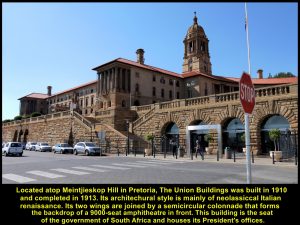
Union Buildings, built in 1910, is the seat of the government of South Africa and houses the President’s offices in Pretoria.
War Monument
Across the road in front of Union Buildings is a large, tall, cylindrical shaped structure with a bronze sculpture of two strong men taming a wild horse atop. It is erected there in memory of the South African soldiers who were killed in WW I(1914-1918) and WW II(1939-1945).
Statue of Nelson Mandela
There are terraced, manicured gardens down the slope where a large, tall statue stands. It is the statue of the first elected President of South Africa, Nelson Mandela(1918-2013) unveiled on 16 Dec 2013, 11 days after his death. He held the office from 1994 until 1999.
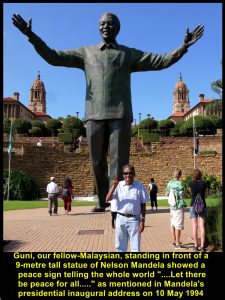
Guni, fellow-Malaysian, standing with a V-sign in front of a 9-metre tall statue of Nelson Mandela at Union Buildings, Pretoria
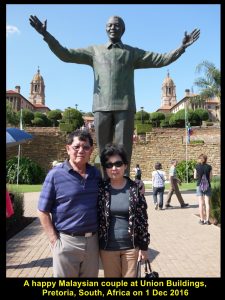
A fellow-Malaysian couple standing in front of the tall statue of Nelson Mandela at Union Buildings, Pretoria
City of Pretoria
The statue of Nelson Mandela standing tall with open arms in the terraced garden on a slope in front of Union Buildings is facing the city of Pretoria in the distance and the scenery is picturesque.
New Friends
In the garden I was surprised to see three of our fellow-Malaysians make friends with strangers, easily, and they took a photo with them, too.
We spent an hour at Union Buildings keeping our cameras and phone-cameras busy.
Voortrekker Monument
Soon we left Union Buildings and went to a historic monument known as Voortrekker Monument located on a hill that is south of the city of Pretoria.
The Great Trek(1835-1854)
Voortrekker Monument was erected in memory of more the 10000 Voortrekkers(Dutch-speaking pioneers) who trekked across treacherous terrains from Cape Colony to the interior inhabited by unfriendly indigenous peoples in north-east of South Africa. They were in search of a homeland that was fertile for farming and free from the British rule. The exodus known as the Great Trek occurred between 1835 and 1854.
Hall of Heroes
There are two halls in the monument, Hall of Heroes and Hall of Cenotaph. Fixed on the walls in the Hall of Heroes in the monument is a long frieze with 27 panels depicting the exodus of the Voortrekkers in the Great Trek, battles fought and treaties signed between the Voortrekkers and indigenous peoples, etc.
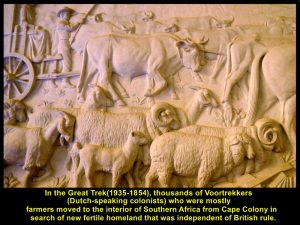
Over 10000 Voortrekkers, mostly farmers, moved to the interior in South Africa in search of new homeland free from the British rule in Cape Colony.
Battle of Blood River(1838)
The Voortrekkers in the Great Trek encountered many battles with the indigenous peoples resulting in many casualties. The well-known battle in the Great Trek was the Battle of Blood River that happened on 16 Dec 1838. It was fought between 470 Voortrekkers and between 15000 and 21000 Zulu attackers on the bank of Ncome River on 16 Dec 1838 resulting in 3000 Zulu casualties and 3 wounded Voortrekker commandos. The battle was won by the Voortrekkers.
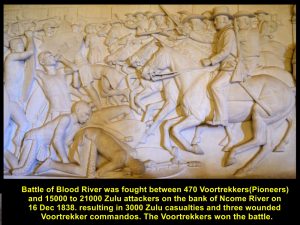
Historical Battle of Blood River on 16 Dec 1838 between 15000-21000 Zulu attackers and 470 Voortrekkers
The Vow
Before the Battle of Blood River on 16 Dec 1838, the Voortrekker men made a public vow together. A tablet in the compound of Voortrekker Monument carries the inscription of The Vow.
The Voortrekkers vowed to God that if He helped them to win the war, they would make that day like a holy Sabbath and build a house to worship Him. Besides, they would tell their future generations to glorify and honour Him.
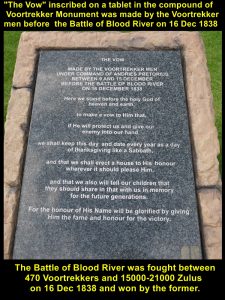
The Vow was made by the Voortrekker men before the Battle of Blood River was fought on 16 Dec 1838.
Treaties
After some battles, peace treaties were signed between the indigenous chiefs and Voortrekker leaders.
Hall of Cenotaph
In the Hall of Cenotaph which is below the Hall of Heroes, there is a cenotaph in the centre with an inscription in Afrikaans, “ONS VIR JOU SUID AFRIKA”(“We for thee, South Africa”). On 16 December every year, sunlight passes through a round glass-dome in the ceiling in Hall of Heroes and the dome focuses the light onto the words on the cenotaph at noon. The date has to do with that of the Voortrekkers’ victorious Battle of Blood River which was fought on 16 Dec 1838.
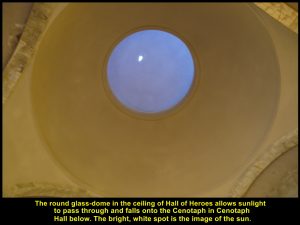
The glass dome focuses the sunlight onto the words on the cenotaph below at noon on 16 Dec every year. The white spot in the dome is the image of the sun.
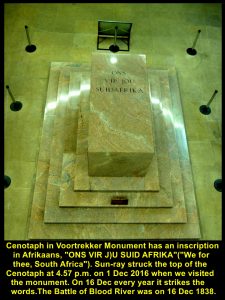
A focused sunlight strikes the top of the Cenotaph at 4.57 p.m. on 1 Dec 2916 when I was there, in Voortrekker Monument.
Voortrekker Woman
A bronze sculpture of a woman with her two children is erected at the base of Voortrekker Monument in recognition of the contributions, perseverance, courage and sacrifices of the Voortrekker women during the Great Trek(1835-1854).
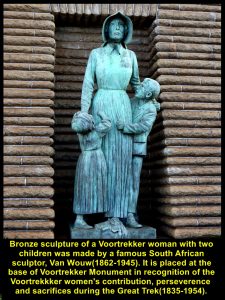
A scuplture of a Voortrekker woman and her children erected at the base of Voortrekker Monument in recognition of the contributions, perseverance and sacrifices of the Voortrekker women during the Great Trek(1835-1854)
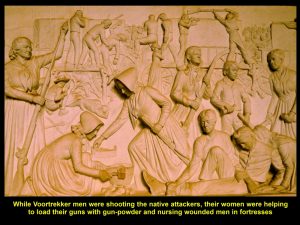
Voortrekker women helped men to load gun-powder and nursed the wounded during the battles against the natives.
Top of Voortrekker Monument
In the Hall of Heroes, we took a lift to the top of the monument which was more than 40 metres high. In the corridor of the monument top, the arches and walls were built in geometrical designs. Looking from the top, we could see a breathtaking view of the city of Pretoria and its surroundings.
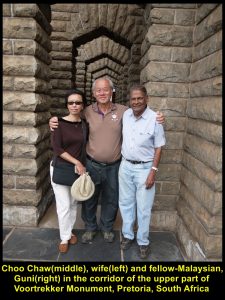
Choo Chaw(middle), wife(left) and Guni(right, a fellow-Malaysian) in the corridor of the top of Voortrekker Monument on 1 Dec 2016
Voortrekkers’ Wagons
Before we left Voortrekker Monument, I saw a wagon near the bottom of the steps of the monument. It was a replica of the ox-drawn wagons used in the Great Trek(1835-1854). Besides transporting heavy things, those wagons were arranged in a circle or laager as a defence against surprise attacks from the indigenous peoples in the interior of South Africa.
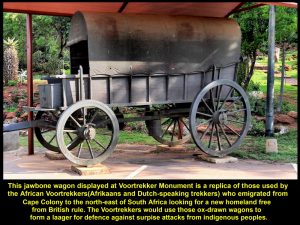
Voortrekkers used this kind of wagon to carry heavy things and arranged many of them in a circle as a defence against surprise attacks in the interior of South Africa.
We left Voortrekker Monument at 5.20 p.m. after spending an hour there. We have learned a lot about the history of Voortrekkers at the monument.
We would visit three more places, Kruger Museum, Church Square and Melrose House, before we had dinner at Carnivore Restaurant.
(continue in South Africa Travel Part VII)
Written by Choo Chaw
South Africa Travel Part I: Air Flight from KLIA to Cape Town, Cape Town Shantytowns
South Africa Travel Part II: Table Mountain, Malay Quarter, Castle of Good Hope. A & V Waterfront
South Africa Travel Part III: Hermanus, Cheetah Outreach, Stellenbosch, Jewel Africa
South Africa Travel Part V: Pilanesberg National Park(Game Drives)
South Africa Travel Part VI: Sun City Resort, Union Buildings, Vootrekker Monument,
South Africa Travel Part VII Kruger Museum, Church Square, Melrose House, Carnivore Restaurant
South Africa Travel Final Part Gold Reef City: Gold Mine Museum
South Africa Travel Part V: Cape Town to Johannesburg, Pilanesberg National Park(Game Drives)
Filed under: Pilanesberg National Park(Game Drives), South Africa Travel Part V: Cape Town to Johannesburg
South Africa Travel Part V: Cape Town to Johannesburg, Pilanesberg National Park(Game Drives)
(continue from South Africa Travel Part IV)
Day 5 Wednesday, 30 November 2016
Departure for Johannesburg from Cape Town
For the past few days we had visited many places in Cape Town City, east of the city and Cape Peninsula. Our next tour would be visiting interesting places in northern part of South Africa.
Early in the morning of 30 Nov 2016, we left the hotel, Southern Sun Hotel in the city, and went to Cape Town International Airport. From the airport, we would fly to Johannesburg, 1262 km in the north-east, for another tour in the north of South Africa.
Farewell to Cape Town Tour Guide, Cindy
Before we flew off to Johannesburg we thanked and said farewell to our Cape Town tour guide, Cindy.
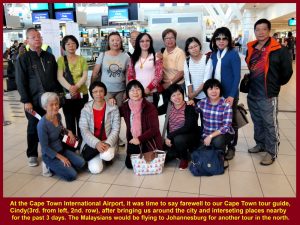
Some fellow-Malaysians taking a farewell photo with Cindy(3rd. person from the left in 2nd. row), the Cape Town tour guide, at Cape Town International Airport
Johannesburg Tour Guide, Graeme
At 9.30 a.m. our plane, a British Airways, finally departed Cape Town Two hours later, we landed at Johannesburg International Airport and were welcomed by a local tour guide, Graeme.
Lunch at Jasmine Palace, Pretoria
Then his coach drove us northwards to Pretoria, a distance of 54 km. On arrival at Pretoria at 1 p.m., we had lunch at a Chinese restaurant, Jasmine Palace.
Pilanesberg National Park
After lunch we continued our journey to a well-known national park, Pilanesberg National Park, which was 160 km north-west of Pretoria. It was that place that we would want to watch wild animals, especially the “Big 5”, and birds.
Pilanesberg Natural Park in a Crater
This park is in a crater of an extinct, large volcano surrounded by rings of hills that are formed from solidified magma exposed by weathering and erosion. The last time the volcano erupted was 1.2 billion years ago.
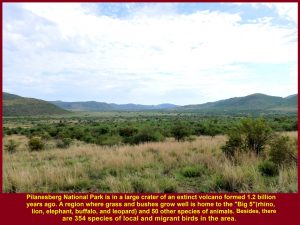
Pilanesberg National Park is in a crater of a large volcano that is extinct since 1.2 billion years ago. A home to 50 species of wild animals and 354 species of both migrant and non-migrant birds.
Now, the park is an area of about 570 sq. km of diverse vegetation and home to over 10 000 protected wild animals of 50 species and 354 species of migrant and non-migrant birds.
Bakubung Lodge, Pilanesberg National Park
The park has a few lodges and camps for tourists to stay and offer game-drives(safaris). In a game-drive, they use their vehicles to bring tourists to the park to see wild animals, including the “Big 5” of lion, elephant, leopard, rhino and buffalo. Bakubung Lodge is one of them where we stayed overnight. It is surrounded by an electrified fence to keep out wild animals.
Late Afternoon Game-Drive(Safari)
At 4 p.m on the first day of our arrival in Pilanesberg National Park, 30 Nov 2016, we checked in at Bakubung Lodge and half an hour later, we began our late afternoon game-drive(safari) in the park.
Jill, a Game-Ranger
A game-ranger of the lodge, Jill, drove seven of us in her 4×4 jeep while the other 21 fellow-Malaysians were driven by another game ranger in a large truck.
As the game rangers drove their vehicles on dirt roads in the park they informed each other the places where animals were sighted through communication devices.
Animals in the Park
The first kind of animals we saw were some zebras grazing on a grassland. As Jill was driving further we felt excited seeing other kinds of wild animals, namely wildebeests, impalas, lions, rhinos and elephants.
Zebras
There are about 1700 zebras in Pilanesberg National Park in South Africa. Their enemies are lions, crocodiles, cheetahs, leopards and hyenas.
Wildebeests
There are about 500 wildebeests in the park and are hunted by lions, cheetahs, leopards and hyenas.
Impalas
Impalas form the largest group of mammals in the park. Its total is about 3000. Like zebras and wildebeests they have the same predators.
Lions
Lions are difficult to be spotted as there are about 50 of them in the park. We were lucky to watch one that came close to our jeep without fear and then walked away to the bushes on a sunny day, 30 Nov 2016.
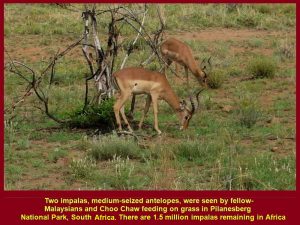
Now 1.5 million impalas remain in Africa
Jackal
A jackal was sighted at a small lake or water-hole. Its back was black. Black-backed jackals are considered the most aggressive of the jackals as it is known to attack animal prey many times its weight.
Rhinos
The number of rhinos is decreasing, annually. Poachers kill them for their horns which are sold in East Asian countries, like China and Vietnam. The people in these countries believe that the horns can treat many ailments, like cancer, rheumatism, gout, fever, typhoid and other diseases.
According to U.S. Fish and Wildlife Service, “rhino horn is made up primarily of keratin – a protein found in hair, fingernails and animal hooves”.
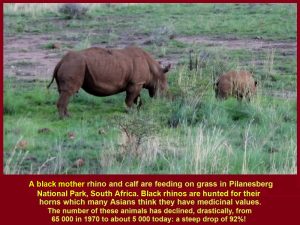
Mother rhino and calf eating grass
Elephants
About 220 elephants live in the park. These are the largest mammals in the park. An adult eats about 150 kg of foliage and drinks 40 litres of water a day. Poachers kill them for their ivory-tusks.
Young male elephants are forced to leave their families and live alone or together with other young ones when they reach puberty at the age of 14-15 years old.
Night-Time
When night fell, Jill tried to look for more animals with her spot-lamp. Several minutes later, she spotted a few impalas crossing the road we were travelling.
Animals seen in Late Afternoon Game-Drive
At about 8 p.m. Jill ended the late afternoon game-drive. Then I recalled the animals that we had spotted in the late afternoon. They were zebras, wildebeests, impalas, a lion, a jackal, rhinos and elephants. But we had not seen leopards and buffaloes belonging to the “Big 5” yet. We hoped to see them the following day.
Lots of Food for Dinner
After the late afternoon game-drive we went to a village to have dinner of native food. There was a lot of “free” food to eat, but we had to pay for drinks, like soft-drinks, beer and wine.
Lots of Drinks for Sale
Diners were spoilt for choice as there were so many kinds of drinks, but they had to pay for any drinks they chose.
Dancing and Singing
While we were having the meal young native boys and girls danced and sang for us. Earlier, those children welcomed us for dinner. After dinner we were driven back to the lodge where we stayed overnight.
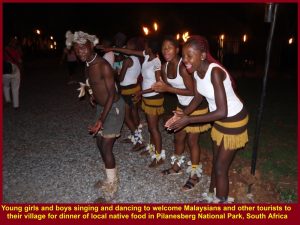
Young native boys and girls dancing and singing to welcome tourists for dinner.
and entertaining them at the meal
Day 6 Thursday, 1 Dec 2016
Morning Game-Drive
On the early following morning, Jill brought us to another part of the park for the morning game-drive(safari). In that part of the park, she told us the types of plants eaten by animals and some, like camomile flowers, were used as insect-repellents by animals.
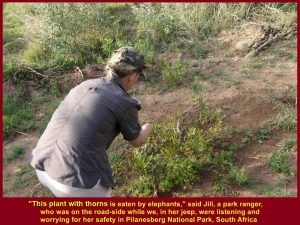
Jill told the Malaysians about the plant with thorns that was eaten by elephants
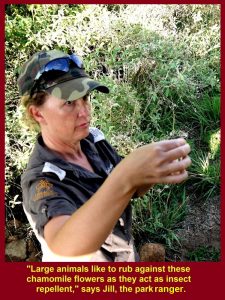
Jill said that those camomile flowers could be an insect-repellent for animals that rubbed against them
Elephants’ Digestion
Elephants are herbivores. They eat a lot of plants every day as 40% of the food is digested and their dung still contains 60% undigested food. Jill showed us a beetle that loved elephant-dung. She said that it would make the dung into a small ball and rolled it backward to its nest.
Foot-Prints of Animals
Besides, Jill showed us some foot-prints on road-sides and told us the animals that had those foot-prints. Every time Jill stepped out of her jeep to show us plants or foot-prints, we, Malaysians tourists sitting in her vehicle, were worried for her safety in Pilanesberg National Park where wild animals were lurking.
Hide
Jill brought us to a hide to watch a few kinds of water-birds, e.g. herons, egrets, eagles, cormorants and kingfishers at a water-hole, and large lake where hippos lived and other animals quenched their thirst.
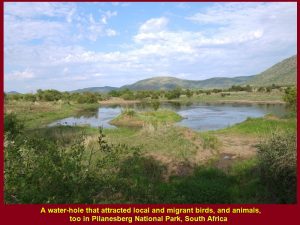
A water-hole that attracted local and migrant birds, and animals, too
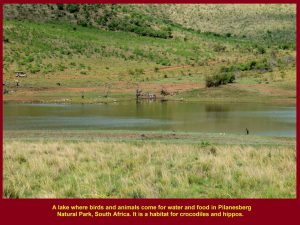
This large lake attracted many birds and animals that went for a drink. Two hippos were spotted in the water.
In the morning game-drive we saw the same animals on the previous day and three more kinds, i.e. giraffes, kudus and sable antelope.
Giraffes
Two young giraffes were seen by us eating leaves on the trees on a hillslope on the morning of 1 Dec 2016.. An adult eats about 34 kg of foliage a day. The number of these mammals that remain in Africa is about 98000 but about 170 live in Pilanesberg National Park.
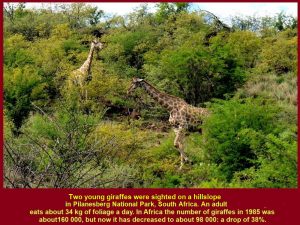
Two young giraffes eating leaves on a hillslope. About 98000 giraffes live in Africa and 170 in Pilanesberg National Park
Kudus
There are about 600 kudus living in Pilanesberg National Park. The males have long, spiral horns whereas the females have no horns.
Sable Antelope
A sable antelope was a rare sight in Pilanesberg National Park. It had two long. curved horns and could weigh as much as 250 kg.
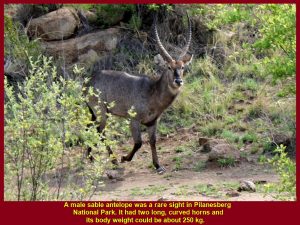
A sable antelope was a rare sight in Pilanesberg National Park. It had two long, curved horns and its body weight could be about 250 kg.
Rest-Place
Each game-drive lasted for 3-4 hours and had a short break at a rest-place where the game-rangers would offer us drinks and snacks. Then the game-drive resumed.
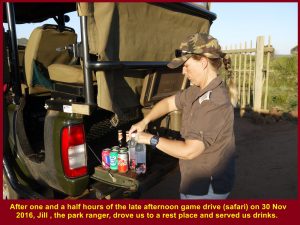
Jill. a park ranger, preparing drinks and snacks for Choo Chaw and fellow-Malaysians at a rest-place
Time for Photographing
Malaysians took an opportunity for photographing at the rest-place.
“Big 5”
When the morning game-drive ended at 8.40 a.m. we felt disappointed for not being able to spot all the five animals in the “Big 5”. We failed to see leopards and buffaloes in the two game-drives(safaris) in Pilanesberg National Park. But we were happy to have seen many kinds of animals not listed in the “Big 5”.
Departure for Sun City
At 10 a.m. we left Pilanesberg National Park for Sun City which was nearby, and then to more places.
(continue in South Africa Travel Part VI)
Written by Choo Chaw
South Africa Travel Part I: Air Flight from KLIA to Cape Town, Cape Town Shantytowns
South Africa Travel Part II: Table Mountain, Malay Quarter, Castle of Good Hope. A & V Waterfront
South Africa Travel Part III: Hermanus, Cheetah Outreach, Stellenbosch, Jewel Africa
South Africa Travel Part V: Pilanesberg National Park(Game Drives)
South Africa Travel Part VI: Sun City, Union Buildings, Vootrekker Monument
South Africa Travel Part VII Kruger Museum, Church Square, Melrose Museum, Carnivore Restaurant
South Africa Travel Final Part Gold Reef City: Gold Mine Museum

